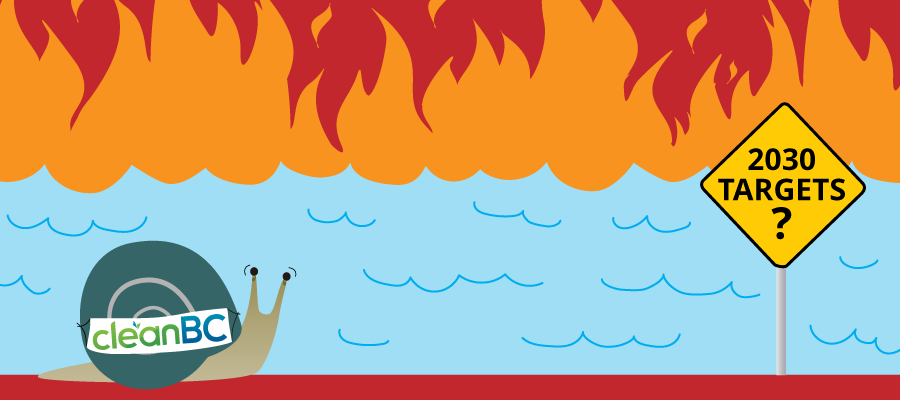What would it take to meet Canada’s 2030 climate targets?

Adapted from the CCPA’s fall 2023 submission to Canada’s Net-Zero Advisory Body by Hadrian Mertins-Kirkwood & Marc Lee
When Canada first signed the Paris Agreement way back in 2015, the commitment to reduce domestic greenhouse gas emissions by 30% below 2005 levels by 2030 seemed far away.
So far away, in fact, that in 2021 the federal government doubled down, promising a 40-45% reduction in emissions by 2030. And while the federal government didn’t yet have a plan to achieve that goal in full, it at least had the time to come up with one.
Now, halfway to 2030, Canada’s greenhouse gas emissions are not falling fast enough—we achieved only a 7% reduction between 2015 and 2021. And time is running short.
Is it still possible for Canada to cut emissions by 30, 40 or even 45% by 2030? If so, what would it take?
Those are the questions that Canada’s Net-Zero Advisory Body (NZAB) recently posed to climate policy experts across the country, including the CCPA. Our submission to NZAB made clear that, while Canada’s Paris commitment is not yet out of reach, setting ourselves on the path to carbon neutrality will require much bolder policies than the federal government has entertained so far.
Elephants in the room
Two elephants stand in the way of decarbonizing the Canadian economy. Together, they imperil both the 2030 Paris goal and Canada’s legislated commitment to achieve net-zero emissions by 2050.
The first is the fossil fuel industry. The extraction and processing of coal, oil and gas accounts for more than a quarter of Canada’s domestic emissions. To make matters worse, since most of those fuels are exported and burned elsewhere, the carbon footprint of Canada’s fossil fuel industry is actually twice as bad as it looks.
Fossil fuels are definitively the root cause of anthropogenic global warming, yet the federal government has studiously avoided tackling fossil fuel supply. Not only has the government continued to approve new fossil fuel projects, but it also maintains generous loopholes and subsidies that allow the oil and gas industry to moderately reduce production emissions without reducing the total amount of oil and gas it is extracting.
The second elephant is the nebulous world of “negative emissions” or “carbon credits,” which refers generally to the idea that we don’t have to stop burning fossil fuels as long as we suck up the same amount of pollution somewhere else.
Canada’s target under the Paris Agreement is not out of reach. Nor is our hope of reaching net-zero emissions by 2050.
In practice, that means deploying carbon capture, utilization and storage (CCUS) technologies for industrial processes, expanding natural carbon sinks like forests and wetlands, and counting on as-yet-uninvented technologies to pull carbon dioxide directly out of the atmosphere.
In its latest modeling, the Canada Energy Regulator relied heavily on the assumption of negative emissions for its net-zero scenarios to the extent of being wildly unrealistic.
First, there are practical problems. Despite the oil and gas industry’s marketing, CCUS has not been developed at a scale commensurate with the problem. And it is prohibitively expensive, which is why those same companies are demanding enormous public subsidies.
Looking to nature to fix our problems is not going to work, either. After a summer of record wildfires across the country, it is clear that Canada’s forests are no longer a carbon sink. Forest carbon offset projects can burn down, releasing all of the carbon they were supposed to store. Moreover, carbon offsets are notoriously difficult to validate and the industry is beset by fraud.
Allowing for negative emissions introduces significant moral hazard into the climate policy discourse. When every industry and jurisdiction believes that it alone will be able to offset its emissions in the future, none feels responsible for cutting emissions at the source.
Even where negative emissions are viable and valid, delaying necessary investments in lower-carbon alternatives increases the risk of stranded assets in the economy and raises the cost of transitioning over the long term.
Sprinting to 2030
Achieving our Paris Agreement target in the next seven years will require specific, rapid government actions. Many of the usual climate solutions, like major green infrastructure projects, simply cannot be finished fast enough to bend the emissions curve down by 2030.
Here’s what will help meet Canada’s climate targets:
- A stringent oil and gas sector emissions cap. The federal government cannot back down from its proposed oil and gas sector emissions cap in the face of industry opposition. A strong cap will immediately drive emissions down and shape long-term investment decisions for the better.
- The phase-out of the output-based pricing system (OBPS). Large industrial polluters, especially the oil and gas industry, are not required to pay the full carbon price on their emissions, a decision made in the name of “competitiveness” for trade-exposed industries. The OBPS loophole was always intended as a temporary solution. It’s time to close the gap with the benchmark carbon price.
- The phase-out of carbon offsets. Nature conservation and reclamation is vital in its own right, and it can also support Indigenous rights, but it is no substitute for reducing fossil fuel emissions. In other words, we should be planting trees and forcing firms to reduce their own emissions. Canada’s GHG Offset Credit System should be wound down.
- Attaching climate conditions to all federal funding. Without strong “green strings,” major programs like the $8 billion Net Zero Accelerator or the $15 billion Canada Growth Fund risk subsidizing continued oil and gas production. All federal funding should have to pass a strict climate test—one that considers not only upstream but also downstream (“Scope 3”) emissions.
- An ambitious public transit investment plan with both capital and operational funding. In addition to major new transit infrastructure, we can improve service levels and reliability for existing transit systems in the short term. More electric buses on dedicated bus lanes can provide a reliable alternative to personal cars to push down transportation emissions.
- An international agreement on fossil fuel supply. Because the Paris Agreement only focuses on territorial emissions, it creates a loophole for fossil fuel producing countries to continue to promote fossil fuel exports. A new international supply agreement would address this collective action problem. Canada should push for a Fossil Fuel Non-Proliferation Treaty to facilitate the orderly wind-down of fossil fuel production worldwide.
Beyond Paris
Even if we hit our aspirational 2030 target of a 45 % reduction below 2005 levels, there is still serious work to do to achieve net-zero greenhouse gas emissions by 2050.
Here are the biggest pieces we need to get right over the long term.
- Transformational green infrastructure spending. The Canadian economy—public and private sector combined—is currently underspending on climate on the order of $100 billion per year. Without more capital, we simply cannot transition away from fossil fuels fast enough. In Spending What it Takes, we present a $287 billion, 5-year climate investment plan that would help close that gap. And while the price tag may look daunting, spending more on climate action today can help us avoid higher transition costs in the future.
- Dedicated support for Indigenous-led climate solutions. Indigenous Peoples have been historically excluded from the climate policy discourse, and many federal climate programs perpetuate a colonial relationship with Indigenous communities. Advancing reconciliation and unleashing the potential of Indigenous Peoples to advance decarbonization requires dedicated funding for climate initiatives that are developed and owned by Indigenous communities themselves.
- A robust just transition framework. Making sure no one is left behind by the transition to a cleaner economy requires both a top-down and bottom-up approach. First, the federal government must adopt a mission-oriented transition strategy that prioritizes public planning and job-creating public investments. Second, the federal government should support, but not direct, community-level transition planning. Each community and region must be empowered to chart their own path forward.
- More ambitious interim targets. Even 45% by 2030 is not enough. To do our fair share, given Canada’s historical contribution to climate change and our capacity as a rich country to act, we would need to reduce emissions by closer to 60% by 2030. As the federal government considers its 2035 interim target, it would do well to aim for at least a 70% net reduction and a 60% gross reduction (i.e., before accounting for negative emissions).
Running out of time
Canada’s target under the Paris Agreement is not out of reach. Nor is our hope of reaching net-zero emissions by 2050. But the federal government’s current, incrementalist approach will not get us there.
We need to dream bigger and adopt much more aggressive climate policies. And we need to do it while avoiding the pitfalls of oil and gas extraction and the false promise of negative emissions.
It won’t be easy. But the longer we wait, the harder it gets.
Topics: Climate change & energy policy, Environment, resources & sustainability


